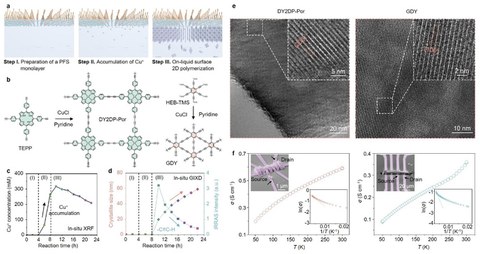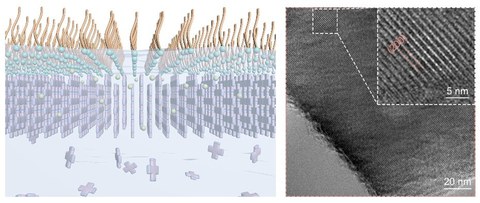11.09.2025
On-liquid surface synthesis of diyne-linked two-dimensional polymer crystals
Two-dimensional polymers (2DPs) and their layer-stacked covalent organic frameworks (2D COFs), represent an emerging class of crystalline, covalently bonded polymeric networks with periodic order extending in two dimensions. Conventionally, these materials are synthesized under solvothermal conditions using dynamic covalent chemistry (DCC), including reversible Schiff-base condensations, boronic acid condensations, and quasi-reversible Knoevenagel reactions, which leverage error-correction mechanisms to promote the formation of highly ordered frameworks. In contrast, the synthesis of 2DPs via irreversible carbon–carbon (C–C) coupling reactions remains in its infancy, as the absence of reversibility hinders error correction and makes achieving high crystallinity in solution-based systems exceedingly challenging. To address these limitations, interfacial strategies such as on-metal surface synthesis, on-water surface synthesis, and liquid–liquid interfacial synthesis have been developed, as they provide a confined 2D space that facilitates monomer preorganization and enhances reactivity. Among these, on-metal surface synthesis has enabled the fabrication of crystalline 2D conjugated polymers through irreversible C–C coupling, yet strong monomer–metal interactions restrict long-range domain growth and complicate transfer to other substrates. Conversely, on-water and liquid–liquid interfaces offer weaker monomer–surface interactions but suffer from low coupling efficiency. Thus, despite recent advances, the controlled synthesis of crystalline 2DPs via irreversible C–C coupling remains a formidable challenge, owing to the inherent tension between ordered monomer assembly and reaction kinetics.
A recent article by researchers from the TU Dresden and Max Planck Institute of Microstructure Physics, published in Nature Communications, presents an on-liquid surface (a mixture of N,N-dimethylacetamide and water, DMAc-H2O) synthesis method for constructing diyne-linked 2DP (DY2DP) crystals via Glaser coupling, assisted by a perfluorosurfactant (PFS) monolayer. In-situ spectroscopic and diffraction techniques reveal that the well-ordered PFS monolayer facilitates the accumulation of Cu+ ions and subsequent vertical coupling of acetylenic monomers on the DMAc-H2O surface. Building on these findings, we successfully synthesized microscale rod-shaped DY2DP-Por or graphdiyne (GDY) crystals through the polymerization of porphyrin- or benzene-based monomers, respectively. Our study represents a significant advancement in the field of on-liquid surface chemistry and opens up enormous opportunities for constructing C–C bond-linked 2DP crystals with unique functionalities.
Acknowledgements: This work was financially supported by the ERC Synergy Grant (2DPolyMembrane, grant no. 101167472), ERC starting grant (FC2DMOF, grant no. 852909), ERC Consolidator Grant (T2DCP), DFG project (2D polyanilines, no. 426572620), GRK2861 (no. 491865171), CRC 1415 (Chemistry of Synthetic Two-Dimensional Materials, no. 417590517), as well as the German Science Council and Center of Advancing Electronics Dresden. We acknowledge DESY (Hamburg, Germany), amember of the Helmholtz Association HGF, for the provision of experimental facilities. Parts of this research were carried out at PETRA III and we would like to thank Dr. Chen Shen, Rene Kirchhof and Dahdouli Monika for assistance in using photon beamline P08. Beamtime was allocated for proposals I-20230315 and I-20230364.
Reference: Ye Yang, YufengWu, Chang Liu, Mike Hambsch, Tiange Dong, David Bodesheim, Mahabir Prasad, Arezoo Dianat, Thomas D. Kühne, Gianaurelio Cuniberti, Stefan C. B. Mannsfeld, Stuart S. P. Parkin, Renhao Dong, Zhiyong Wang, and Xinliang, On-liquid surface synthesis of diyne-linked two-dimensional polymer crystals, Nat. Commun. 16, 8243 (2025). https://www.nature.com/articles/s41467-025-63768-6.
DOI: 10.1038/s41467-025-63768-6
Picture 1:
a,b) Schematic illustration of the synthetic procedure for DY2DPs on the DMAc-H2O surface. c,d) In-situ XRF and GIXD measurements for the 2D polymerization on the DMAc-H2O surface. e) TEM images of DY2DP-Por and GDY crystals. f) Temperature-dependent conductivities of DY2DP-Por and GDY crystal device with Pt contacts.
Copyright: ©Springer-Nature (https://www.nature.com/articles/s41467-025-63768-6)
Picture 2:
Copyright: ©Springer-Nature (https://www.nature.com/articles/s41467-025-63768-6)
Contact: Ye Yang
+49-015257529565


